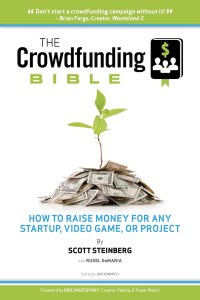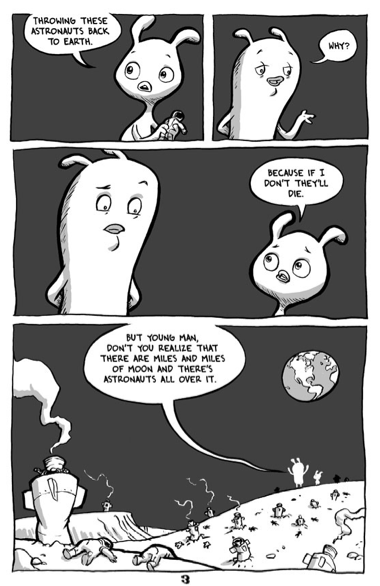The following is an excerpt from Scott Steinberg’s new book, The Crowdfunding Bible. The book is free to download at www.CrowdFundingGuides.com, or in e-book form on Apple, Nook and Sony Reader devices. Check out the previous excerpt: How Kickstarter helped bring back a musical legend.
Jake Parker, Artist and Illustrator
Jake Parker is the creator of the graphic novel series Missile Mouse from Scholastic, illustrator of The New York Times bestselling picture book Awesome Man, and has developed concept art for animated features such as Horton Hears a Who, Ice Age III, and Rio. When Jake decided that he wanted to publish a collection of all of the short comic stories he’d been drawing over the past eight years, he turned to crowdfunding.
Q. Why use online fundraising techniques to bring in investment dollars for your project?
A: My book has such a niche market that both my agent and I felt that it wouldn’t be of interest to publishers. I’ve self-published before, and it’s hard to get exposure. Kickstarter seemed the perfect platform to launch this project from.
I had been watching Kickstarter for a year or so. I watched both the most successful campaigns and those that didn’t reach their funding goals. I took note of what worked and what didn’t. The big takeaway from watching these projects unfold was as follows: Presentation is key. I knew for my project to be successful that it had to look expertly done and presented in a clean and professional way.
Going into this, I had a good idea of who my target audience was. I met with a group of them to see if there was interest in something like my book. The response was overwhelmingly positive, so I proceeded with the project.
Q. Where else did you turn for support and advice when plotting your campaign?
A: A big help was being able to talk directly to others who had conducted successful Kickstarter campaigns. If I didn’t know them, I introduced myself in an email and set up a time to Skype with them. In every instance, they were extremely open and helpful. I also shared my project plans with friends and family who were from different demographics so that I could get their unique perspectives. Feedback ranged from commentary from retirees in their sixties to input from twenty-somethings still in college to contemporaries in my field. Some suggested offering lower pricing and pledge levels, while others thought I should raise the costs associated with each pricing tier. Some said I didn’t have enough information in my pitch, and others said that I was too specific. So I took all of these thoughts and decided which were best for this project.
 Q. What steps were involved in the actual production of the campaign?
Q. What steps were involved in the actual production of the campaign?
A: The main thing I wanted done well, and knew that I wouldn’t be able to do on my own, was the video. I always watch the videos which appear on Kickstarter, and I’ve seen everything from webcam recordings to professionally-done clips. So to produce mine, I called in a favor from a guy I work with who does video. We made a deal that we’d exchange services. He’d put together a little video for me, and I’d draw up something nice for a project he was doing.
The rest involved coming up with a cohesive visual style that presented the material and read well. I used [software program] Adobe Photoshop to put all my images together.
Q. How did you go about designing your rewards?
A: My approach was to make something for everyone. There are people out there with just a little cash on-hand, and then there are the guys who just got a bonus and are looking to burn it – I wanted make something for all. But the bread and butter of your funding will come from offering a reasonable reward for a reasonable amount of money to reasonable people. So make sure there’s something for them too. Otherwise, I contacted printers and got quotes for how much my books would cost. I calculated shipping costs, and factored in the amount that Kickstarter and Amazon take from contributions, and I factored in a little extra for unexpected hiccups as well.
Q. How did you handle the launch, PR and marketing campaign?
A: I’m small-time so I did it all myself. My strategy came about by looking at what had worked for others and seeing if any of these strategies applied to me, determining what options did and then implementing them. My advice is to already have a strong relationship with your audience before you ask for money. People can smell a rat. As for my top tip: Use Twitter and Kickstarter. Twitter spread the word so fast and got people excited. That drove up the popularity of my project and got it on the popular page at Kickstarter, which drove many more eyes to my page.
Q. What about the post-launch phase – how’s that working out?
A: It’s so much more time-consuming than I had expected. The main interaction with my community happens at Twitter, so it’s no different than during the campaign. People ask me questions there, and I answer them there. But I do suggest making time to build your community before launching the campaign. Make them fans first, then they’ll back whatever you do.
 Professional keynote speaker Scott Steinberg is a leading expert on leveraging new technology trends to enhance business strategy and family life. He is also a noted industry consultant and bestselling author.
Professional keynote speaker Scott Steinberg is a leading expert on leveraging new technology trends to enhance business strategy and family life. He is also a noted industry consultant and bestselling author.
Top image: Jake Parker
VentureBeat's mission is to be a digital town square for technical decision-makers to gain knowledge about transformative enterprise technology and transact. Learn More

